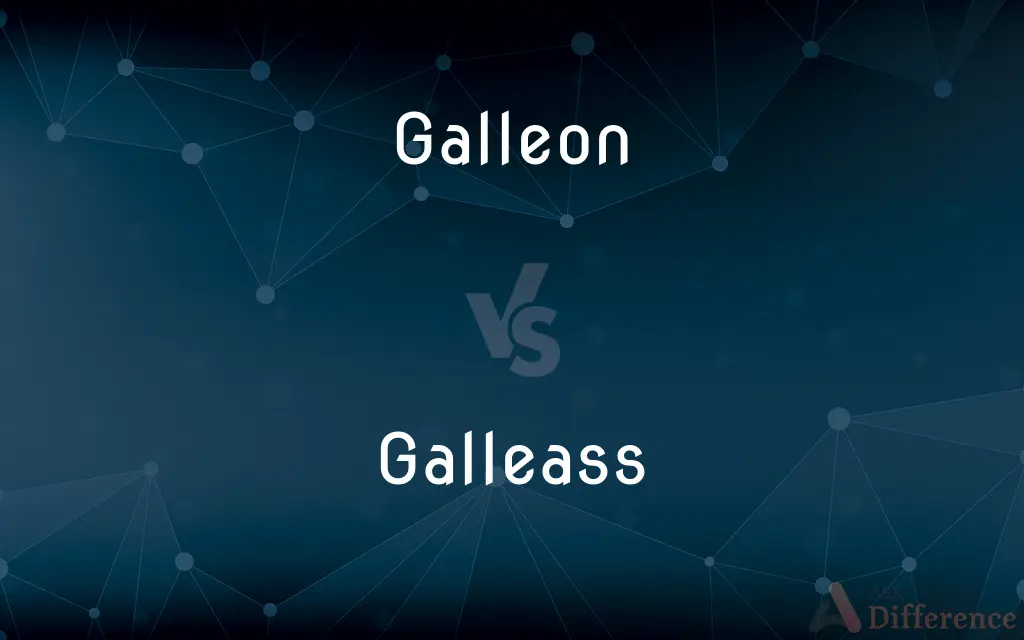Galleon vs. Galleass — What's the Difference?
By Tayyaba Rehman & Fiza Rafique — Updated on April 18, 2024
Galleons were large, multi-decked sailing ships used primarily by European powers in the 16th to 18th centuries, designed mainly for warfare. Galleasses were a hybrid sailing and rowing vessel, larger than a galley and equipped with broadside cannons.

Difference Between Galleon and Galleass
Table of Contents
ADVERTISEMENT
Key Differences
Galleons were primarily built for ocean-going ventures, carrying both cargo and armaments, making them central figures in maritime warfare and exploration. In contrast, galleasses were developed to combine the speed and maneuverability of galleys with the firepower of sailing ships, used mainly in Mediterranean warfare.
Galleons featured a square rig and three or more masts, typically known for their robust structure and extensive firepower, making them suitable for long voyages and heavy battles. Meanwhile, galleasses, equipped with both oars and sails, could navigate effectively in both the open seas and near the coast, providing tactical advantages in shallower waters.
The design of a galleon included a high aftcastle and a distinctive beakhead at the bow, which were not only functional for battle but also served as symbols of naval power. On the other hand, galleasses were characterized by their lower profiles and substantial rowing capacity, accommodating up to 300 rowers, which was crucial for quick maneuvers during combat.
The armament on a galleon was more heavily reliant on its cannons, strategically placed along the gun decks to maximize broadside attacks. Whereas galleasses, although similarly armed, also maintained a complement of smaller firearms and boarding weapons, reflecting their dual function in both sailing and oaring scenarios.
In terms of usage, galleons were often part of larger fleets and were instrumental in transoceanic voyages, including those that established and maintained colonial empires. Galleasses, however, were particularly notable in key naval battles in confined waters, such as the Battle of Lepanto in 1571, where their versatility was a significant factor in combat effectiveness.
ADVERTISEMENT
Comparison Chart
Primary Use
Ocean-going warfare and trade
Coastal and confined water warfare
Propulsion
Sails only
Sails and oars
Size and Structure
Larger, robust, multiple decks
Smaller, lower profile
Armament
Heavily armed with cannons
Cannons and small arms
Notable Usage
Transoceanic voyages and battles
Mediterranean naval battles
Compare with Definitions
Galleon
Integral to the establishment and maintenance of overseas colonies.
Galleons carried settlers to the Americas, along with supplies and weapons.
Galleass
A type of galley that was larger and equipped with broadside cannons.
The galleass was rowed into position before unleashing a devastating broadside.
Galleon
Designed for deep-water expeditions, featuring multiple decks and a high aftcastle.
Galleons often featured elaborate decorations on their sterns and aftcastles.
Galleass
Played a critical role in battles by combining speed, maneuverability, and firepower.
At Lepanto, galleasses were positioned at the front lines to break through the enemy formations.
Galleon
Known for their extensive use in naval warfare and significant carrying capacity.
The fleet consisted mostly of galleons, ready for both combat and transport.
Galleass
Capable of independent sailing and effective rowing, suitable for various naval tactics.
The galleass used its oars to maneuver swiftly around the enemy's flank.
Galleon
Featured in many historic battles against pirates and rival nations.
Galleons were vital in defending the treasure fleets against pirate attacks.
Galleass
Less common than galleons but notable for their unique design and tactical applications.
Despite their effectiveness, galleasses were outnumbered by the more versatile galleons.
Galleon
A large sailing ship used from the 16th to 18th centuries, especially by European powers for warfare and trade.
The Spanish galleon was heavily laden with gold from the New World.
Galleass
Used predominantly in the Mediterranean for both warfare and protecting trade.
Galleasses patrolled the Mediterranean, protecting merchant ships from corsairs.
Galleon
Galleons were large, multi-decked sailing ships first used as armed cargo carriers by European states from the 16th to 18th centuries during the age of sail and were the principal vessels drafted for use as warships until the Anglo-Dutch Wars of the mid-1600s. Galleons generally carried three or more masts with a lateen fore-and-aft rig on the rear masts, were carvel built with a prominent squared off raised stern, and used square-rigged sail plans on their fore-mast and main-masts.
Galleass
Galleasses were military ships developed from large merchant galleys, and intended to combine galley speed with the sea-worthiness and artillery of a galleon. While perhaps never quite matching up to their full expectations, galleasses nevertheless remained significant elements in the early modern naval armoury for some considerable time.
Galleon
A sailing ship in use (especially by Spain) from the 15th to the 18th centuries, originally as a warship, later for trade. Galleons were typically square-rigged and had three or more decks and masts
A Spanish treasure galleon wrecked off the Florida Keys
Galleass
A large, fast, heavily armed three-masted Mediterranean galley of the 1500s and 1600s.
Galleon
A large three-masted sailing ship with a square rig and usually two or more decks, used in the 1500s, 1600s, and 1700s, especially by Spain as a merchant ship or warship.
Galleass
A type of rowable vessel of the 16th and 17th centuries, similar to a galley but larger, and normally equipped with sails.
Galleon
A large, three masted, square rigged sailing ship with at least two decks.
Galleass
A large galley, having some features of the galleon, as broadside guns; esp., such a vessel used by the southern nations of Europe in the 16th and 17th centuries. See Galleon, and Galley.
Galleon
A sailing vessel of the 15th and following centuries, often having three or four decks, and used for war or commerce. The term is often rather indiscriminately applied to any large sailing vessel.
The galleons . . . were huge, round-stemmed, clumsy vessels, with bulwarks three or four feet thick, and built up at stem and stern, like castles.
Galleon
A large square-rigged sailing ship with three or more masts; used by the Spanish for commerce and war from the 15th to 18th centuries
Common Curiosities
What tactical advantages did galleasses offer in naval battles?
The combination of oars and sails gave galleasses superior maneuverability and the ability to maintain their position regardless of wind conditions, making them effective especially in the constrained waters of the Mediterranean.
Can you describe the structural differences between a galleon and a galleass?
Galleons were larger with multiple decks and a high aftcastle, designed for deep-sea navigation and heavy armament. Galleasses had a lower profile with fewer decks, optimized for speed and quick maneuvering.
What kind of voyages were galleons typically used for?
Galleons were typically used for transoceanic voyages, engaging in trade routes across the Atlantic and Pacific, often involved in colonial expansion efforts.
What era marked the peak use of galleons, and when did they decline?
The peak use of galleons occurred from the 16th to the mid-17th century, declining as ship designs evolved towards more streamlined and heavily armed ships like ships of the line.
How did the construction costs and maintenance of galleons compare to galleasses?
Galleons, due to their size and complexity, were generally more expensive to construct and maintain compared to galleasses, which, while still costly, required less material and labor due to their smaller size and simpler design.
How did the crew size and composition differ between galleons and galleasses?
Galleons generally required a larger crew, including specialized officers, sailors, and soldiers, due to their size and armament. Galleasses, while also requiring a substantial crew, had a significant proportion of rowers.
Why were galleons considered important in historical naval warfare?
Galleons played a crucial role in naval warfare due to their heavy armament and ability to transport troops and goods across vast oceanic distances, influencing the outcomes of many significant naval conflicts.
In what context were galleasses more effective compared to galleons?
Galleasses were especially effective in coastal waters and confined naval battles where their ability to quickly maneuver and deliver broadsides was strategically advantageous.
How did the armament of a galleon compare to that of a galleass?
Both ships were heavily armed; however, galleons typically carried more and larger cannons configured for massive broadsides, while galleasses also included a range of smaller arms and were capable of versatile tactical actions.
Were galleasses used by all major naval powers in the same way?
No, galleasses were primarily used by Mediterranean powers, such as Venice and Spain, tailored to the specific conditions of Mediterranean naval warfare.
What were the main roles of galleons in the Spanish Treasure Fleet?
In the Spanish Treasure Fleet, galleons primarily served as transport vessels for silver and gold from the Americas to Spain, while providing robust protection against pirates and enemy nations.
What impact did galleasses have on the outcome of the Battle of Lepanto?
Galleasses played a pivotal role at Lepanto by using their artillery and maneuverability to disrupt the formations of the Ottoman fleet, contributing decisively to the Christian victory.
What were the common destinations for voyages undertaken by galleons?
Galleons commonly sailed to the Americas, East Asia, and Africa as part of trade and colonial expeditions, connecting continents in global trade networks.
Did galleasses participate in trade, or were they strictly warships?
Galleasses were primarily designed as warships, although they sometimes escorted merchant convoys and participated in anti-piracy operations to protect trade routes.
Share Your Discovery

Previous Comparison
Pity vs. Shame
Next Comparison
Gargantuan vs. GiantAuthor Spotlight
Written by
Tayyaba RehmanTayyaba Rehman is a distinguished writer, currently serving as a primary contributor to askdifference.com. As a researcher in semantics and etymology, Tayyaba's passion for the complexity of languages and their distinctions has found a perfect home on the platform. Tayyaba delves into the intricacies of language, distinguishing between commonly confused words and phrases, thereby providing clarity for readers worldwide.
Co-written by
Fiza RafiqueFiza Rafique is a skilled content writer at AskDifference.com, where she meticulously refines and enhances written pieces. Drawing from her vast editorial expertise, Fiza ensures clarity, accuracy, and precision in every article. Passionate about language, she continually seeks to elevate the quality of content for readers worldwide.
















































